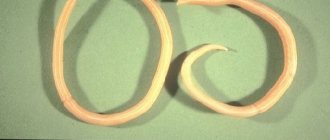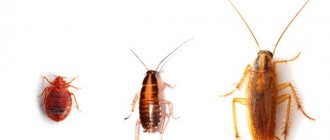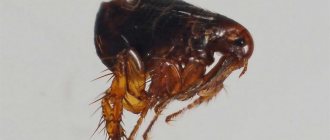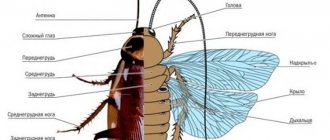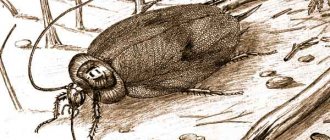The high fertility of cockroaches is one of the main reasons for their high survival rate. A distinctive feature of the species is that a female can mate with a male only once, and then produce offspring several times during her life. At the same time, cockroach eggs are more difficult to destroy than adult ones. They are protected by the ootheca, a membrane that is resistant to chemicals and other external factors. The death of all insects does not guarantee complete ridding of the house from parasites. If among them there were females with ooteca, then a few days after treatment of the room, nymphs may hatch from them. One solution to the problem is to re-apply the insecticide after 10-14 days. In the article, we will look at the difference between an egg and an egg, how many embryos one female produces in a lifetime, and also how to rid your home of annoying parasites.
Features of the appearance of larvae
Quite interesting is the fact that some pests demonstrate a certain maternal instinct towards their offspring.
When cockroaches hatch from the eggs of a Madagascan representative, they crawl under the mother’s abdomen and remain under her direct protection for some time. The female hisses and makes threatening lunges when potential danger approaches. However, such care is only enough for 1 day. Classic Prussians practically do not care for their young. The offspring simply stays near the female for a few more hours, after which they scatter to secluded corners.
One of the interesting exceptions remains the species of relict cockroaches. In their case, after the “birth” of young individuals, they are looked after and provided with food. Upon reaching a certain degree of maturity, new members of society take their assigned place in the hierarchy of the colony. In this case, it is somewhat reminiscent of a termite mound with different ranks and its own complex hierarchy.
Appearance of the ootheca
The formation of the cockroach ootheca begins simultaneously with the appearance of eggs. It is located under the female’s abdomen and is initially light in color. As the embryos develop, the capsule also increases. The color becomes more saturated, and it closes from the inside. The ootheca, which has increased in size, is no longer compactly located under the female, and becomes clearly visible even to the naked eye.
What the ootheca looks like is determined by the species affiliation of the individual:
- in Prussians, the “incubator” is red, light brown in color with transverse depressions, up to 8 mm long;
- the capsule of black cockroaches is dark brown, up to 1.2 cm in length, with a clearly visible ridge;
- The ootheca of Madagascar cockroaches is very elongated in length, and is also characterized by a bright, rich yellow color.
In the ooteca, cockroach larvae develop from 30 to 80 days. The timing of development is influenced by species, temperature, and humidity. Under favorable conditions and temperatures within 30°C, the larva of the Prussian larva matures in 15–20 days. In black cockroaches, young individuals hatch after 1–1.5 months. Madagascans have the longest pregnancy. Lowering the temperature increases the development time of the offspring.
Unlike adults, ootheca with eggs of domestic cockroaches remains viable at temperatures from –10°C to +55°.
Types of cockroaches and their reproduction
Domestic cockroaches are rightfully considered one of the most unpleasant insects that have ever appeared in our homes. Just by their appearance they cause disgust. In addition, these insects are carriers of pathogenic bacteria, helminth eggs, spoil food and leave their poop. Among the huge number (about 4 thousand) species of insects, only 3 are adapted to life in close proximity to humans:
- redheads;
- black;
- American
They differ from each other in color, size and area.
The homeland of domestic red cockroaches is southern Asia. In the 18th century, they came to Europe and quickly began to multiply. Human dwellings became the habitat. They are still more often found in our homes than others. This synanthropic organism has a body size of 1-1.5 cm. Prussians are equipped with wings, but cannot fly, and are only capable of short-term gliding. Cockroaches in an apartment usually live in dark, cluttered places, crevices, under baseboards, etc.
After mating, the female cockroach places the fertilized eggs in a special cocoon called an ooteca. There, the cockroach larvae are located in 2 rows and 2 tiers. A capsule can contain up to 40 eggs at a time, and in some cases more. The time for embryo maturation depends on the conditions in which the uterus is located - the availability of food and water, as well as the temperature in the room. Typically, cockroaches hatch 2-4 weeks after laying eggs. The process may take several months if the room temperature is below 8-10 °C.
Before eggs can be laid, the female must be fertilized. It is enough for her to meet a cockroach once, and that will be enough for the rest of her life. Over the entire period, cockroaches lay eggs 6-9 times. For some time, females carry the ootheca on themselves and only after 8-10 days they shed it. The place where the cockroaches lay the capsule must be reliably protected from daylight and be warm enough. At a certain time, the larva is born. Red insects are characterized by an incomplete development cycle. To reach sexual maturity, the nymph (larva) must undergo several molting processes.
The little Prussian is completely similar to the adult one, only it does not have wings. Nymphs hatch without chitinous cover and therefore have a white color. Already at this age they move quickly. As a rule, insects do not move far from the hatching site. For some time it serves as a shelter for them. Adults are not responsible for hatching nymphs.
Black beetle
These insects are distributed throughout Europe. With the arrival of the Prussians, black cockroaches gave up their primacy, but continue to terrorize homes. The red cockroach happily feasts on the found egg of its black fellow. The lifespan of these insects is slightly more than 6 months. Unlike red ones, black ones almost immediately shed their ootheca. Therefore, some of the eggs die even before maturity.
A black pregnant cockroach produces much fewer offspring than a black cockroach. Usually it lays up to 30 eggs, and taking into account those eaten by red insects and the eggs lost during maturation, less than half of the larvae will hatch. Just like red ones, they are born without wings and have a white color, because... There is practically no chitin in the body. Only with age do their bodies acquire a black color with a characteristic shine.
Newly born and adult cockroaches differ little from each other. These insects rarely settle on the upper floors of the house. Typically, black cockroaches live in basements and on the lower floors of buildings, as well as in garbage disposals. They tolerate cold better, and at temperatures below -10 ° C they die. The cockroaches abandon the hatched young. From this moment on, the offspring are competitors in the territory of residence of the adults. In an abandoned capsule, cockroaches may be born after several months if the external conditions are not suitable for the maturation process.
Insects differ from each other not only in the color of their chitinous coating, but also in size. Black cockroaches are almost 3 times larger than their red counterparts and reach a length of almost 5 cm. However, this does not prevent red insects from displacing competitors from the territory they like. The damage caused by black cockroaches is no less than that caused by Prussians.
Fighting cockroaches
Knowing what domestic cockroaches look like makes it much easier to deal with them. To exterminate them, not only traditional mechanical destruction is used, but also a whole arsenal of chemicals - insecticides. If the residents decide to completely get rid of these aliens, then for this it is necessary to exterminate not only the adult individuals, but also the laid eggs, and for this you need to know what cockroach eggs look like.
You need to look not for small balls less than 0.5 mm in size, but for hard brown capsules with rows of laid eggs. The ootheca must be collected and destroyed. This is the only way to get rid of the unborn cockroach offspring, otherwise many dozens more nasty insects will hatch. In places where oothecae are located, as a rule, there are no adult individuals, since they are not present at hatching.
In order to completely get rid of harmful insects, and the labor spent on these activities is not in vain, it is necessary to kill the cockroach offspring. But to do this you need to know what small cockroaches look like. Usually these are fast running insects, slightly larger than a poppy seed. Most often they can be found in the area where the trash can is located and sources of moisture.
To more effectively get rid of cockroaches, the fight against them must be carried out in adjacent apartments, and ideally - in the entire house at the same time. Otherwise, these insects will migrate through ventilation and other openings. After properly carried out disinsection, many are surprised at the number of insects eradicated from the apartment.
It is necessary to maintain cleanliness in areas where pests may appear. First of all, this is the kitchen, bathroom, storage rooms. If, a few days after disinfestation, traces of harmful insects appear, do not despair. Work on the destruction of pests must be continued, since it will give a positive result only with the integrated use of all types of control.
In addition to cockroaches, other insects may appear in the apartment. During the warm season, a beetle can fly into almost every room through an open window. But how to distinguish a cockroach from a beetle? The most important difference between them is that a beetle that gets into an apartment can fly. He can always be recognized by the absence of a long mustache. They differ in color and body shape. It is not at all necessary to know what beetle larvae look like. All alien beetles live on the street and enter the apartment completely by accident. Therefore, the offspring of these insects are not born indoors, but go through completely different stages.
Many people think that cockroaches only cause harm, but this is not entirely correct. Scientists have calculated that if all cockroaches are destroyed, about 10 thousand species of living beings inhabiting our planet will become extinct.
About the reproduction of cockroaches
Do cockroaches lay eggs? Yes they do. In fact, they "lay" many eggs at the same time. Like many animals, the cockroach's reproduction depends on eggs from the female and sperm from the male. Typically the female releases pheromones to attract a male, and in some species males fight over available females. But what happens after a male deposits his sperm into a female varies from species to species.
After mating, female cockroaches lay their eggs in a secure oval capsule called an ootheca. When the eggs are almost ready to hatch, the mother of most species either drops it near a food source or uses oral secretions to stick it to a suitable surface.
Features of reproduction
With the onset of puberty, cockroaches look for a pair to reproduce. They use pheromones to attract partners. After transferring the spermatophore, the male leaves the female. A special feature of insects is the ability of females to store their partner’s seed material. She can use it more than once in the future.
The short ovipositor of females is hidden in the abdomen. Here are the ducts of the glands that produce fluid for the construction of the capsule. After fertilization, the female cockroach with the egg appears thicker and her abdomen increases in size. To form an egg cocoon, there is a reproductive chamber inside the insect. It is filled with a foamy protein secretion, it quickly hardens and creates a capsule shell.
Information. Not everyone knows the name of the shell in which cockroach eggs are packaged. This is ootheca, a concept formed from two Greek words “egg” and “storage”.
Not knowing the structure of the capsule and surprised by its size, people wonder how many cockroaches hatch from one egg? Each egg contains one embryo, which as it develops turns into a larva. There are more than 10 of them under the chitinous shell. The chamber protects against low temperatures (-10°) and heat (55°). In it, the offspring survive the effects of insecticides, which are harmful to adults.
Information. The chitinous shell does not save the larvae from parasites; they destroy the walls and penetrate inside.
What do cockroach eggs look like?
It is rarely possible to examine the eggs of arthropod insects; they are reliably hidden from prying eyes. The shelters of the embryos are light, transparent, with an outer and inner shell. Gas exchange occurs through tiny pores in their walls. They are vulnerable to mechanical damage, temperature fluctuations, and bacterial infection. These dangers can be avoided by placing them behind the walls of a durable shell.
One by one, the eggs are laid in 2-4 even and dense rows. Each is lubricated with a sticky liquid and tightly attached to the others. After the process is completed, the secretion of the glands stops, but the secretions are enough to seal the cocoon. The ootheca does not completely fit into the abdomen of females; part of it is clearly visible.
The shape and size of the cocoon depends on the family and species of insects. It can be from 8 to 25 mm long. Various colors: yellow, pink, brown. The capsules are oblong, embossed, and have a characteristic scallop. At this point, the larvae gnaw through the wall of the shelter and escape to freedom. The grooves and bumps on the sides indicate the egg chambers. The average number of capsules produced by a female during her life is 5-9 pieces.
How many eggs a cockroach lays at a time depends on its species. The female German cockroach leaves 30-40 pieces in the capsule, the Egyptian cockroach 14-18, the black cockroach - up to 50. On average, the incubation period is 30-90 days. The rate of embryo maturation depends on the ambient temperature. The optimal temperature is 30° and moderate humidity. In cool conditions (15-18°), the development of embryos stops.
Where do cockroaches lay their eggs?
Insects try to protect their offspring from various dangers. They leave the ootheca with mature embryos in a secluded place. For some species, it is enough to hide the capsule from enemies; for others, climatic conditions are important. There must be suitable temperature and humidity level. In tropical species, the shell may dry out. In this case, the offspring dies or is born weakened.
Many species of tropical arthropods bear their young in their own bodies. They do not shed the capsule; it remains in the genital chamber. The hatched larvae emerge from the abdomen of the female. Such insects are called ovoviviparous. They have a more developed maternal instinct than their relatives. At first, the nymphs do not leave the female, seeking refuge on her back. The mother protects the offspring, hisses and drives away enemies.
Interesting fact. During prolonged gestation of the ootheca with its offspring, the female periodically pushes it outside for ventilation.
Black cockroaches leave the egg capsule unattended for the entire period of embryo maturation. Over a period of 40-50 days, predatory representatives of other species find it and destroy the defenseless offspring. Prussians act more carefully; their cocoon remains on the female’s body almost until the larvae hatch. This species is distinguished by its fertility and high survival rate of offspring. Females leave clutches in dark and secluded corners of the apartment:
- ventilation duct;
- space behind the gas stove and bulky furniture;
- under the sink;
- behind the baseboards;
- near the trash can.
In the process of fighting parasites, it is important to find and destroy the offspring, otherwise the population will quickly restore its numbers.
Cockroach larvae
The process of gnawing through the ootheca takes from several minutes to an hour. The offspring are born with a soft cover, without the coloring characteristic of the species. At first they stay near the shell, which serves as their first food. Nymphs are white, transparent, the only dark spots on the body are black compound eyes. Their body structure resembles that of an imago. A distinctive feature is the absence of wings, sexual characteristics, and a small number of segments on the antennae.
Nymphs darken and become covered with a chitinous shell by the end of the first day of life. Their body size is 1-2 mm. At this age, young animals arrive from a month to 2-4 years. The rate at which they reach sexual maturity depends on the species of cockroaches and their lifespan. There are several other contributing factors:
- temperature (high indicators accelerate development, low indicators slow down);
- quantity and quality of food;
- humidity, which helps with shedding.
Nymphs lead a secretive lifestyle and, in natural conditions, often burrow into the soil. The diet is similar to that of adults. During the growth process, the chitinous cover becomes small, it is periodically shed and replaced with a new one. This process is called molting. Before reaching adulthood, young animals experience it 5-12 times. After the premago stage, wings appear in flying species. The transition to the adult stage means the insects are ready to reproduce.
Interesting fact. The use of edema is also typical for praying mantises. They hang structures made from frozen secretions at the bottom of tree branches.
The attitude towards cockroaches and their eggs depends on the type of insect. Exotic species that do not harm people are popular. They are kept as pets. The attitude towards red Prussians is different. Synanthropic cosmopolitans infect and spoil food, wallpaper, books, and paper. They are mercilessly destroyed.
How many cockroaches will hatch from one egg?
In 30-75 days, a larva forms from the egg. The duration is determined by external factors. Optimal conditions for rapid development are high humidity and a temperature of about +30 °C. In a less favorable microclimate, the maturation of the nymph slows down, but does not stop. The embryos grow by absorbing nutrients. If the ootheca compartment becomes crowded, they gnaw through the membrane and come out.
If we talk about how many cockroaches will hatch from one egg, then it would be correct to say that there is only one. But this question in most cases refers to the number of embryos in one protective capsule.
Nymphs of red cockroaches are located in the lower and upper parts of the ooteca, 15-24 pieces each. Thus, from 30 to 48 larvae hatch from one egg. The American, Oriental and other larger species produce fewer offspring: a maximum of 16 nymphs hatch from one egg.
At the final stage of development, the nymphs independently open the egg shell and scatter in search of food and a secluded place.
How are they born?
The larval development phase ranges from 35 to 75 days. The cockroach prefers to breed where it is warm and humid. At temperatures close to zero, the development of the embryo stops. In this case, the appearance of offspring is postponed to a later date - when optimal conditions for full formation arise.
Embryos gradually increase in volume as they feed on all the necessary substances inside the egg. When the larva becomes uncomfortable, it makes a hole in the egg and, gnawing through the ootheca shell, finds itself outside. This birth technology is observed in females who separate the capsule. If the “incubator” matures inside the body of a pregnant individual, then the larvae independently leave the insect’s body.
The time period for the appearance of offspring varies from half an hour to 3-4 hours. At first, the insects are white and translucent. But over time, the outer cover of young cockroaches hardens and at the same time changes color to a dark color.
What do cockroach eggs look like?
In practice, you will never see this, because they are securely hidden in a capsule, from which a small cockroach will then emerge.
Cockroach eggs are a real mobile nursery
Prussians are the most common type of cockroaches. They are about a centimeter long and have a light brown capsule, about 3 mm long and 1.5 mm wide. Females of most other species briefly carry the newly extruded egg "case" for a short time, give birth to it, and then hide it or "glue it" in a hidden, protected location. The nymphs hatch a few weeks later. The mother of the red cockroaches, however, is very protective of her offspring, and carries an ootheca with eggs protruding from her abdomen for two to three weeks until all the babies hatch. She is viviparous.
The Prussian egg capsule has a series of indentations on each side. Each depression outlines an egg compartment inside, which develops into a developing nymph. Each capsule can contain from 30 to 48 developing nymphs. If you open the capsule, you will see 15-24 nymphs lined up in both the top and bottom half. Eventually, the fully developed nymphs open their protective cover and seek shelter in your kitchen!
How many eggs does a cockroach lay?
How long do cockroaches live? The lifespan of a cockroach is usually one year, and during the life of any female, she can produce 200 to 300 offspring or 6 generations per year. The number of eggs a single cockroach can produce will vary from species to species. Potentially, and under optimal conditions, a single female Goose and her offspring could produce 300,000 babies per year. This means that if you're not careful, a relatively small infestation can quickly develop into a much more serious problem that must be dealt with quickly.
How many cockroaches will hatch from one egg?
If you are trying to control cockroaches, you should also ask how to kill the parasite's offspring. Why? Because one “egg” can turn into 50 young cockroaches if you don’t stop them right away. Fear not, there is a proper way to deal with them to prevent them from hatching. It's important to know how to do it right so you don't waste all your efforts. Black and red members of the community should not continue to hatch.
How to destroy cockroach eggs
The main difficulty in fighting cockroaches is not to detect and destroy all the adults, but to get rid of the eggs. They are reliably protected by ootheca, which is highly resistant to insecticides, water, chemical components, and pathogenic viruses. The shell easily allows air to pass through and withstands cold down to -11°C.
Knowing the physiological and biological characteristics of red cockroaches, you can choose the best option for destroying cockroach eggs. Our goal is to get rid of not only adult individuals, but also females with ooteca. To do this, you should adhere to the following recommendations:
- At the first stage, it is necessary to disinfest the premises. She must destroy all adults.
- If there were a lot of cockroaches in the house, then there is a high probability that several females managed to form a clutch of eggs. A few days after treatment, you may encounter annoying parasites again. To completely destroy the insects, you can re-disinfest the room or try using traditional methods.
One of the popular methods of destroying larvae is freezing. If previously the larvae were protected by the ooteca, then the hatched nymphs can no longer withstand negative factors. They are detrimentally affected by the same conditions as adults. Natural frost disinfestation can only be done in winter. To do this, you will need to leave the apartment for a day, opening all the windows and the balcony wide. Cockroaches die if the temperature drops to -3°C. In some cases, the procedure must be repeated 2 times.
Among folk methods, one can also note the use of aromatic plants, their oils and various concentrated decoctions. But such methods are more suitable as auxiliary or deterrent. They will help create a protective barrier and reduce the likelihood of cockroaches reappearing, but will not be effective in killing them.
It is easier and more effective to use chemicals. In special departments of the store you can find traps, gels, crayons, baits and other types of preparations. Please read the instructions carefully before use. When applying the chemical component, gloves and respiratory protection should be used. Particular attention should be paid to cracks, holes, the space under the baseboard, bathtub, sink, cabinets and other dark and hard-to-reach places.
Video
How to get rid of cockroaches. Ways to control cockroaches
Cockroach eggs can protect offspring from insecticides
Swellings with eggs cannot be removed with insecticides. When there is a massive cockroach infestation, you will see both hatched and unhatched egg capsules among the carcasses, shed skins, and other debris. The egg capsule before poisoning appears full and plump, while the hatch may appear split, bruised or wrinkled.
You can see why German cockroaches are so successful. They have more nymphs per egg than any other species, and the female gives birth to 4-8 clutches in her lifetime. The strong outer shell of the egg storage capsule is resistant to insecticides, so new whiskered insects can hatch within days or weeks of pest control. You should make sure that you or your pest control contractor schedules follow-up maintenance to kill any nymphs that appear during this time.
Where do females hide their eggs?
In order to effectively combat pests, a person should know where, most likely, the female will leave her clutch. She mainly chooses secluded, inaccessible places where her offspring will not be disturbed.
These are:
- Gaps between furniture.
- The space under the bedside tables.
- Along or behind baseboards.
- In the ventilation ducts.
- On shelves in the pantry.
- Under the sink.
Knowing the location of the eggs, you can better fight cockroaches. If even a hint of unwanted guests appears, it is worth taking measures to eliminate them. Fortunately, at the moment there are quite a lot of different ways to destroy this type of insect.
And this is what the process of “birthing” cockroaches into the world looks like:
The birth process of cockroaches
Cockroach larvae can be born in several different ways, which depend on the species of insect. For example, a female red-headed hawk carries an ootheca almost until the nymphs hatch, after which she leaves the capsule in a secluded place.
Madagascar, the females of which, unlike the male, cannot fly, have a slightly different method of reproduction. Their eggs also mature in the ooteca, but it is located in the abdomen of the female. When the offspring are born, the misleading impression is created that the female is giving birth, since the larvae emerge from her abdomen.
The method of hatching larvae characteristic of Madagascar cockroaches is called ovoviviparous. However, this does not at all mean that the larvae, while in the mother’s body, are not isolated from her body; only viviparous animals are capable of this.
The eggs are also in a dense capsule, which is hidden under the hard shell of the female for additional protection. This reduces the risk of eggs being eaten by predators.
How many cockroaches hatch from one egg?
Many people are probably interested in this kind of question: how many cockroaches hatch from one egg? Strictly speaking, one egg can only contain one cockroach. The ootheca can accommodate clutches of various sizes; this aspect depends on the species of the adult.
For example, capsules of red Prussians contain up to fifty eggs, while black ones can reproduce offspring at a time, the total number of which will be about one hundred individuals.
Are there viviparous cockroaches?
Cockroaches are not viviparous creatures. The terms “ovoviviparous” and “oviparous” are used for these insects.
If the embryo develops in an egg and does not receive nutrition from the mother’s body during development, but is still in the female’s body, then this method of reproduction is called ovoviviparity.
Those cockroaches whose females simply leave their ootheca to the mercy of fate are typical oviparous insects. The same species in which the eggs develop inside the female’s body, and the nymphs hatch simultaneously with their exit from the brood chamber, are ovoviviparous.
Therefore, the terms “pregnant cockroach” and “viviparous cockroaches” are not entirely correct - only viviparous animals are truly pregnant.
From a scientific point of view, the expression “cockroaches give birth” is not entirely correct. This process is not called childbirth, but birth.
In the photo there is a female Madagascar cockroach with nymphs emerging from her abdomen:
What do eggs and egg capsules look like?
Quite often, ordinary people confuse cockroach eggs with dense capsules called oothecae. This specific dense shell, the chemical composition of which is somewhat similar to the shell of bird eggs, contains masonry inside.
The capsule with cockroach eggs reliably protects them from the effects of negative environmental conditions, while the embryos receive the air necessary for growth and formation.
Depending on the subspecies of the insect, the ootheca may contain a different number of eggs. For example, the capsule of the most common red Prussian can hold up to fifty units.
It develops in the abdominal cavity of the female, which lasts for a certain period, the duration of which depends on the presence or absence of favorable conditions, and can range from a month to three.
When the eggs mature, the female looks for a suitable place for her offspring, after which she leaves the ootheca in a secluded corner. How many days do cockroaches hatch from eggs? If the ootheca is surrounded by favorable conditions, this hatching occurs after three to four weeks.
In the absence of sufficient heat, the maturation of eggs slows down; the brood may appear in two to three months.
The eggs themselves, enclosed in the ootheca shell, are microscopic - no more than a millimeter in size, white in color, and transparent. It is important to know what a cockroach larva, ootheca, and parasite eggs look like. This will help identify masonry and prevent the spread of pests.
Where and how often are egg capsules laid?
In order to get rid of parasites forever, it is recommended to know where the eggs of red cockroaches are especially often located.
Since sufficiently comfortable conditions are necessary for the development of masonry, cockroaches often lay masonry in such secluded corners of the apartment as: the joints of wallpaper, the space under them, as well as tiles, cracks between floorboards, ventilation holes, the space under the bathroom, kitchen furniture.
In order to prevent the spread of insects, it is recommended to thoroughly vacuum the places where a cockroach can lay eggs; this measure, as well as maintaining cleanliness of the home, will help to eliminate the appearance of parasite colonies as much as possible.
Masonry places
In nature, cockroaches lay eggs:
- in damp forest floor;
- in the cracks of stones;
- in rotting wood.
There are no such places in the apartment. But the capsule cannot be seen lying in the middle of the kitchen. All cockroaches are nocturnal insects. In the apartment during the day they hide in dark corners. The ideal place for domestic parasites to live is the cabinet under the sink and the kitchen stove that never moves away from the walls. Females mainly lay eggs in the apartment there. You can find an ooteca somewhere else, but it will always be a dark, secluded place. The capsule lying in plain sight was lost by a cockroach in a moment of danger.
Possible locations of the ootheca
The presence of cockroaches in apartment buildings has remained a problem for many years. These insects have become so adapted to human habitation that they successfully find safe places to breed:
- in ventilation compartments;
- in the cracks behind the baseboard;
- in the cracks present between parts of furniture;
- under washbasins, sinks, cabinets, beds;
- in utility rooms and storage rooms.
When cleaning an apartment, you come across dry shells of insect capsules. They must be taken out of the apartment to the trash can. If an ootheca of cockroaches is found, then it must be destroyed - there is a risk of the birth of a large number of pests.
Fighting cockroach populations on your own is a thankless task, because it is ineffective. The best way to get rid of it is to call a pest control service.
Where to find
Cockroaches strive to leave behind as many offspring as possible from one egg laying. Therefore, insects usually deposit oothecae in hard-to-reach places. For example, in the pantry, ventilation system, under the sink, in furniture, behind and under baseboards.
Having discovered “barbels” in an apartment, simply destroying them is not enough. Indeed, in the near future the population will be completely restored due to the hatched individuals. Therefore, you also need to look for capsules and destroy them.
Pest Control
Having considered all the intricacies of the maturation and development of these unpleasant insects, we can determine the rules for combating them. To minimize the risks of the formation and reproduction of colonies, it is necessary to narrow the number of potential areas where cockroaches live. The ideal option would be to renovate the apartment - fill holes in the floor and seal cracks in the walls, re-glue the wallpaper, cover the ventilation compartments with a fine mesh.
You need to watch the bread crumbs very carefully. The slightest amount of them in a room will provide energy to an insect colony for almost a month. It’s not worth mentioning about the accumulation of garbage in the apartment. It is important to isolate pests from access to water, and it is better to protect yourself from guests from neighbors with special poisonous traps.
Ventilation of rooms is necessary daily. But in winter, sub-zero temperatures are detrimental to eggs. Hot steam treatment helps, but this can only be done by specialists. You should also remember that one-time cleaning of the room will not give results - several treatments are required.
Lifespan of a cockroach
But not all cockroaches breed alone, but they all grow by leaps and bounds, producing baby after baby in the apartment. Clutch after clutch, birth of brood of larvae after brood and so on without stopping.
Different types of cockroaches have a fairly active sex life and a wide variety of preferences.
Thus, female cockroaches of the species Nauphoeta cinerea do not choose partners with the highest reputation or, presumably, the greatest sexual attractiveness. Rather, they prefer "underdogs" who are constantly suppressed by their dominant counterparts. This is the strange sex life of cockroaches from Tanzania, which have set their own special standards in choosing a partner.
One of the hypothetical versions: macho cockroaches do everything to separate “loving” females and males. Another assumption: females seek weak males not out of compassion, but because of the rudeness of the stronger sex. Otherwise, they risk getting hurt during rough lovemaking.
How dominant male cockroaches are can be determined by their smell. Previous research has shown that smaller males produce a veritable cocktail of three pheromones compared to females. If two specific odors outweigh, this cockroach is considered dominant and is not attacked. If, on the other hand, the third one predominates, then everything is bad.
The characteristic body odor, however, also has a disadvantage: it tells females which cockroaches are more likely to be aggressive and should therefore be avoided. A vicious circle results: driven away by females, the dominant cockroaches become even more aggressive, and the weak ones in the colony have to suffer even more.
But another fact struck cockroach researchers: females that mate with a weak male usually have fewer sons than daughters. Perhaps, as biologists speculate, females want to maintain competition in the next generation and thus offer their male offspring a better chance among more females. But perhaps there is also fear behind this: the fear of giving birth to too many weak offspring.
As soon as the nymphs mature, they become adults, begin to mate and lay new oothecae with eggs. The average lifespan of an American cockroach from egg to adulthood ranges from 168 to 786 days. Adult females live longer and can live up to 786 days, while adult males can live up to 362 days.
German cockroaches also, after the last molt, nymphs become sexually mature adults capable of reproduction. The average lifespan of males is from 100 to 150 days. Females can live anywhere from 190 to 200 days.
On average, cockroaches live in apartments for 1 year. The duration is genetically determined to be 2 years. Insects die from chemicals, mechanical stress, from deadly fights among themselves, in the struggle for survival. When there is a catastrophic shortage of food, cannibalism begins. Adult fertile females live no longer than 210 days, males die earlier.
How to prevent mass reproduction
Chemical treatment is perhaps the most reliable and fastest way to get rid of these pests in the house. In this case, the insects die almost immediately, but this does not in any way affect the larvae, which at this moment are still in the ooteca. After some time, they will quietly hatch, and the problem with cockroaches will arise again.
To avoid this, after the first disinfestation, this activity should be repeated after 2 or 3 weeks in order to “finish off” the hatched young.
In addition, it is important to maintain cleanliness in the house: do not leave food open, take out the garbage on time, monitor the humidity in the apartment, and then the chances of unwanted neighbors will become much less.
Cockroaches can release gases, and after death they continue to release gases for another 18 hours, so cockroaches can be called the stinkiest insects in the world, and not bedbugs, as many believe.
Why is ootheca needed?
This is a way to protect offspring. The cocoon consists of a quickly hardening protein secretion that glues the entire clutch together. The adhesive mass inside partially protects future offspring from impacts on a hard surface. A hard analogue of the chitinous cover prevents the masonry from drying out in the heat or sinking during rain. The capsule also protects the masonry from the cold. If the imago dies at -5°C, then the clutch remains alive even at -11°C. In modern conditions, the protective shell has another function: to save the offspring of pests from insecticides. As long as the larvae have not emerged from the ooteca, they are safe.
How to get rid of cockroach eggs forever?
Knowing how many cockroaches are in one egg is important not only for interest, but also for destruction. Since cockroaches reproduce quickly, a full-fledged colony is formed within a few months. And if the conditions are favorable for development, then one month is enough
Destruction with such representatives usually looks like military action. Especially if a person cannot decide on his own how to remove the animal from the house
And if the conditions are favorable for development, then one month is enough. Destruction with such representatives usually looks like military action. Especially if a person cannot decide on his own how to remove the animal from the house.
There are three options:
- calling services. This service is provided in any city by special enterprises. This is convenient because the owners will only have to clean the premises after visiting specialists. This means collecting destroyed parasites. Of course, you will also need to prepare at home before starting the procedure;
- folk method. There are many recipes here. The main thing is to choose an effective and powerful one. If the insects have just appeared, then egg and borax balls will do. If the parasites have already multiplied, then in addition to the balls you will have to use herbs and other plants and substances;
- chemicals. This group includes gels, traps and aerosols. Their use always gives results faster than traditional recipes.
But it is worth noting that more than one species cannot remove cockroach eggs from the house. Chemicals used by industrial disinfectants have the greatest impact on eggs.
How to get rid of cockroaches at home
It is rare to find an adult who has not seen red cockroaches in everyday life. If he did not have these nimble mustaches in his house, then they were found in institutions, catering establishments, hostels, and low-class hotels.
Red cockroaches are often called cockroaches; they are very interesting insects. Prussians have very developed antennae. Thanks to this, the insect smells and communicates with other individuals. When an antenna is injured or lost, the pest does not receive enough information. Favorable home conditions with a temperature of +20 degrees contribute to the annual lifespan of the red pest. During this period, the female lays a huge number of eggs, which contributes to the expansion of the population.
How to get rid of pet cockroaches at home
Due to the fact that the home conditions of an apartment with heat, water and food contribute to the expansion of the offspring of domestic Prussians, getting rid of them is not so easy. When the population of these harmful insects has not yet expanded, preventive measures that do not have a chemical basis should be carried out. Such means include:
- laying out branches of strong-smelling plants around the apartment: St. John's wort, mint, wormwood, tansy, chamomile;
- washing floors with the addition of a decoction of bay leaves, ammonia, bleach, essential oils;
- paint, kerosene, denatured alcohol, turpentine;
- forming and laying balls of egg yolk and boric acid around the apartment;
- installation of drinking bowls for the Prussians, consisting of water with boric acid;
- installation of various traps in which the Prussians will drown or stick.
Red cockroaches in the apartment: how to get rid of them - ways and means
Due to the fact that residents have long been tired of red Prussians, all sorts of methods are used to combat them. Some apartment owners, when leaving their home, leave them without water. To do this, cover the kitchen sink with a towel so that insects cannot get the required source.
An effective way to get rid of cockroaches in an apartment is considered to be a do-it-yourself trap made from a packet of yogurt, kefir, or fermented baked milk. This product needs to be eaten, and the Prussians should only be left with paper packaging with food residue on the walls. Insects will crawl to the smell, but will not be able to stay on the walls of the bag, falling into the water with which the container will be filled.
Red pests do not tolerate boric acid. An effective folk method is to form balls from boiled egg yolk, mashed potatoes and boric acid. Such balls must be placed near the baseboards. You can also place drinking bowls of water with boric acid around the apartment. You can sprinkle boric acid in places where these insects accumulate.
If simple remedies do not help, they turn to more serious methods of chemical exposure. These include various sprays, gels, powders, and crayons.
The best remedies for cockroaches in the apartment
At any time, in different household conditions, different means of combating red Prussians are used. For some rooms, “Mashenka” crayons will be sufficient, but in other conditions more effective methods will be required:
- gels “Global”, “Raptor”, “Rubit” “Dohloks”, “Brownie” “Kombat”, “Kapkan”, “Absolute”;
- aerosol “Combat”, “Raid”, “Clean House”, “Raptor”, “Dichlorvos”, “Executioner”, “Regent”, “Karbofos”, “Mashenka”, “FAS”, “Get”, “Cucaracha”.
Fighting red cockroaches with sprays leads to an instant effect. But this drug does not affect eggs. Gels work well. The insect that received the dose of the drug will die. But it will bring poison into its hole, infecting other members of the family. This method of getting rid of pests leads to the destruction of red Prussians, as they eat their dead relatives.
What are cockroaches afraid of in an apartment?
It has been established that cockroaches in the apartment are afraid of strong odors. They don't like:
- aromatic essential oils, kerosene, denatured alcohol, ammonia, oil or nitro paint, bleach;
- St. John's wort, wormwood, tansy, mint, chamomile.
Folk remedies for cockroaches that are harmless to humans, the smells of which cockroaches do not like, lead to their expulsion from the apartment. Therefore, do not neglect such simple prevention methods that will allow you to get rid of a possible problem.
To get rid of Prussians for a long time, it is necessary to destroy existing insects and prevent the appearance of new ones. Any methods that do not harm humans are good for this. Pleasant reviews from consumers are addressed to modern gels: “Absolute”, “Combat”, “Raptor”. Aerosol cans of the brands “Raid”, “Dichlorvos”, “Regent” remain always popular.
How and where oothecae are deposited
This is what the ootheca of a cockroach looks like
The ootheca is a reliable protection for the eggs developing inside. It is considered an important evolutionary step for cockroaches, increasing the survival of these insects in hostile environments. By leaving the edema in a protected place, the female can continue to feed without exposing her offspring to the danger of dying along with her due to clumsiness and is soon able to acquire offspring again.
This is interesting! Ootecae are not a unique property of cockroaches; mantises and some mollusks protect their offspring in this way. In addition, only a third of cockroach species have oothecae.
The formation of an ootheca takes 20-75 days in a fertilized female. A pregnant female creates it from a special substance that quickly dries in air, forming a strong, elastic and breathable capsule. As the size of the ootheca increases, the fertilized eggs are immersed in a viscous secretion and remain there until hatching. During this time they mature. Before the nymphs emerge from them, the female sheds the swelling in a secluded place, blocking the entrance. Newborn cockroaches chew through the swelling and come out.
The duration of egg development depends on temperature and humidity. Cold, heat and dryness during the period when the swelling has already been relieved can completely destroy the cockroach offspring. This must be taken into account when developing measures to prevent their occurrence and spread.
That is why a pregnant female very carefully chooses places for clutches, often preferring flower pots and wet rags to secluded but dry cavities under baseboards and behind wallpaper.
Particularly popular places among black cockroaches are garbage heaps, wet rags, glass wool and damaged pipe insulation.
Mobile periplanets are capable of leaving oothecae inside clothes and suitcases, providing their offspring with settlement in various countries and continents.
Favorite places to place ootheca are spaces under baseboards, ventilation, secluded places under the bathroom or inside utility boxes.

